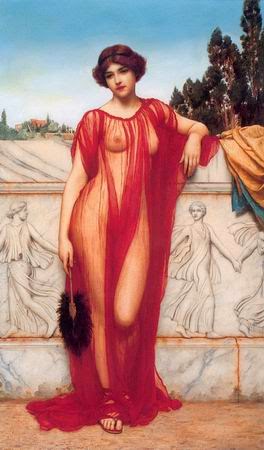IT is Hestia’s glory that, alone of the great Olympians, she never takes part in wars or disputes. Like Artemis and Athene, moreover, she has always resisted every amorous invitation offered her by gods, Titans, or others; for, after the dethronement of Cronus, when Poseidon and Apollo came forward as rival suitors, she swore by Zeus’s head to remain a virgin for ever. At that, Zeus gratefully awarded her the first victim of every public sacrifice, because she had preserved the peace of Olympus.
b. Drunken Priapus once tried to violate her at a rustic feast attended by accident or in token of mourning, it is kindled afresh with the aid of a fire-wheel.
1. The centre of Greek life-even at Sparta, where the family had been subordinated to the State-was the domestic hearth, also regarded as a sacrificial altar; and Hestia, as its goddess, represented personal security and happiness, and the sacred duty of hospitality. The story of her marriage-offers from Poseidon and Apollo has perhaps been deduced from the joint worship of these three deities at Delphi. Priapus’s attempt to violate her is an anecdotal warning against sacrilegious ill-treatment of women-guests who have come under the protection of the domestic or public hearth: even the ass, a symbol of lust, proclaims Priapus’s criminal folly.
2. The archaic white aniconic image of the Great Goddess, in use throughout the Eastern Mediterranean, seems to have represented a heap of glowing charcoal, kept alive by a covering of white ash, which was the most cosy and economical means of heating in ancient times; it gave out neither smoke nor flame, and formed the natural centre of family or clan gatherings. At Delphi the charcoal-heap was translated into limestone for out-of-doors use, and became the omphalos, or navel-boss, frequently shown in Greek vase-paintings, which marked the supposed centre of the world. This holy object, which has survived the ruin of the shrine, is inscribed with the name of Mother Earth, is about the size and shape of a charcoal fire needed to heat a large room. In Classical times the Pythoness had an attendant priest who induced her trance by burning barley grains, hemp, and laurel over an oil lamp in an enclosed space, and then interpreted what she said. But it is likely that the hemp, laurel, and barley were once laid on the hot ashes of the charcoal mound, which is a simpler and more effective way of producing narcotic fumes. Numerous triangular or leaf-shaped ladles in stone or clay have been found in Cretan and Mycenaean shrines-some of them showing signs of great heat-and seem to have been used for tending the sacred fire. The charcoal mound was sometimes built on a round, three-legged day table, painted red, white, and black, which are the moon’s colours; examples have been found in the Peloponnese, Crete, and Delos-one of them, from a chamber tomb at Zafer Papoura near Cnossus, had the charcoal still piled on it.


Comments
Post a Comment